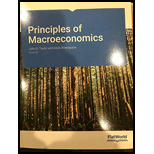Solutions for Principles Of Macroeconomics V 8.0
Problem 1SCQ:
In many casinos, a person buys chips to use for gambling. Within the casinos wafts, customers often...Problem 2SCQ:
Can you name some item that is a store of value, but does not serve the other functions of money?Problem 3SCQ:
If you are out shopping for clothes and books, what is easiest and most convenient for you to spend:...Problem 4SCQ:
For the following list of items, indicate If they are in M1, M2, or neither: Your 5,000 line of...Problem 5SCQ:
Explain why the money listed under assets on a bank balance sheet may not actually be in the bank?Problem 6SCQ:
Imagine that you are in the position of buying loans in the secondary market (that is, buying the...Problem 7RQ:
What are the four functions that money serves?Problem 9RQ:
What is the double-coincidence of wants?Problem 10RQ:
What components of money do we count as part of M1?Problem 11RQ:
What components of money do we count in M2?Problem 12RQ:
Why do we call a bank a financial intermediary?Problem 13RQ:
What does a balance sheet show?Problem 14RQ:
What are a banks assets? What are its liabilities?Problem 15RQ:
How do you calculate a banks net worth?Problem 16RQ:
How can a bank end up with negative net worth?Problem 18RQ:
What is the risk if a bank does not diversify its loans?Problem 19RQ:
How do banks create money?Problem 20RQ:
What is the formula for the money multiplier?Problem 21CTQ:
The Bring it Home Feature discusses the use of cowrie shells as money. Although we no longer use...Problem 22CTQ:
Imagine that you are a barber in a world without money. Explain why it would be tricky to obtain...Problem 23CTQ:
Explain why think the Federal Reserve Bank tracks M1 and M2.Problem 24CTQ:
The total amount of U.S. currency in circulation divided by the U.S. population comes out to about...Problem 25CTQ:
Explain the difference between how you would characterize bank deposits and loans as assets and...Problem 27CTQ:
Explain what will happen to the money multiplier process if there is an increase in the reserve...Problem 28CTQ:
What do you think the Federal Reserve Bank did to the reserve requirement during the 20082009 Great...Problem 29P:
If you take 100 out of your piggy bank and deposit it in your checking account, how did M1 change?...Browse All Chapters of This Textbook
Chapter 1 - Welcome To Economics!Chapter 2 - Choice In A World Of ScarcityChapter 3 - Demand And SupplyChapter 4 - Labor And Financial MarketsChapter 5 - ElasticityChapter 6 - The Macroeconomic PerspectiveChapter 7 - Economic GrowthChapter 8 - UnemploymentChapter 9 - InflationChapter 10 - The International Trade And Capital Flows
Chapter 11 - The Aggregate Demand/aggregate Supply ModelChapter 12 - The Keynesian PerspectiveChapter 13 - The Neoclassical PerspectiveChapter 14 - Money And BankingChapter 15 - Monetary Policy And Bank RegulationChapter 16 - Exchange Rates And International Capital FlowsChapter 17 - Government Budgets And Fiscal PolicyChapter 18 - The Impacts Of Government BorrowingChapter 19 - Macroeconomic Policy Around The WorldChapter 20 - International TradeChapter 21 - Globalization And ProtectionismChapter A - The Use Of Mathematics In Principles Of EconomicsChapter B - The Expenditure-output Model
Book Details
Taylor and Weerapana present modern economics in a form that’s intuitive, relevant, and memorable to learners with no prior exposure to the subject.
Principles of Macroeconomics
engages students by emphasizing the central idea of economics throughout: that people make purposeful choices with scarce resources and interact with other people when they make these choices. The authors bring to bear recent and extensive classroom-based experiences to select real-world examples of how markets work; provide clear explanations of why markets are efficient when the incentives are right and inefficient when the incentives are wrong; and outline examples of economic choices students actually face. The authors stress long-run fundamentals, but they also discuss current public policy issues when the short run matters.
Sample Solutions for this Textbook
We offer sample solutions for Principles Of Macroeconomics V 8.0 homework problems. See examples below:
Chapter 1, Problem 1SCQChapter 2, Problem 1SCQChapter 3, Problem 1SCQChapter 4, Problem 1SCQChapter 5, Problem 1SCQChapter 6, Problem 1SCQChapter 7, Problem 1SCQChapter 8, Problem 1SCQChapter 9, Problem 1SCQ
Chapter 10, Problem 1SCQChapter 11, Problem 1SCQChapter 12, Problem 1SCQChapter 13, Problem 1SCQChapter 14, Problem 1SCQChapter 15, Problem 1SCQChapter 16, Problem 1SCQChapter 17, Problem 1SCQChapter 18, Problem 1SCQChapter 19, Problem 1SCQChapter 20, Problem 1SCQChapter 21, Problem 1SCQChapter A, Problem 1RQChapter B, Problem 6RQ
More Editions of This Book
Corresponding editions of this textbook are also available below:
Principles of Microeconomics
16th Edition
ISBN: 9781938168246
Principles of Macroeconomics
16th Edition
ISBN: 9781938168253
Principles of Macroeconomics 2e
2nd Edition
ISBN: 9781947172388
PRINCIPLES OF MACROECONOMICS
2nd Edition
ISBN: 9780357129128
Principles Of Macroeconomics
7th Edition
ISBN: 9780538453554
Principles of Macroeconomics for AP® Courses
1st Edition
ISBN: 9781938168963
PRINCIPLES OF MACROECONOMICS F/AP (OER)
2nd Edition
ISBN: 9781593998813
PRINCIPLES OF MACROECONOMICS (OER)
2nd Edition
ISBN: 9781947172425
PRINCIPLES OF MACROECONOMICS
2nd Edition
ISBN: 9781506699882
Principles of Macroeconomics by OpenStax
17th Edition
ISBN: 9781506698243
PRINCIPLES OF MACROECONOMICS (OER)
2nd Edition
ISBN: 2810023110024
PRINCIPLES OF MACROECONOMICS
14th Edition
ISBN: 2810015433506
PRINCIPLES OF MACROECONOMICS (OER)
2nd Edition
ISBN: 9781947172395
PRIN.OF MACROECONOMICS (B+W,LL)
4th Edition
ISBN: 9781930789982
Principles of Macroeconomics: Economics and the Economy, 4th edition
4th Edition
ISBN: 9780996996334
Principles Of Macroeconomics
5th Edition
ISBN: 9780996095426
PRINCIPLES OF MACROECONOMICS V9.1
9th Edition
ISBN: 9781453339480
PRINCIPLES OF MACROECONOMICS
9th Edition
ISBN: 9781453334997
PRINC.OF MACROECONOMICS (B+W)(LL)**
4th Edition
ISBN: 2818440084720
Related Economics Textbooks with Solutions
Still sussing out bartleby
Check out a sample textbook solution.
